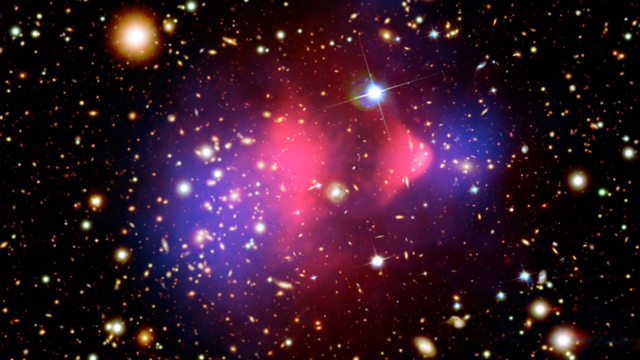It can be easy to take hyped-up science papers as fact, especially when they involve the most esoteric imaginable ideas. But scientists are taking issue with a hyped-up new paper that claims it can eliminate the need for dark matter or dark energy in our universe.
The Bullet Cluster Image: X-ray: NASA/CXC/CfA/M.Markevitch et al.; Optical: NASA/STScI; Magellan/U.Arizona/D.Clowe et al.; Lensing Map: NASA/STScI; ESO WFI; Magellan/U.Arizona/D.Clowe et al.
Observations of our universe imply that something like 95 per cent of it is comprised of mysterious stuff. The maths says it could be explained by an invisible mass called dark matter, and energy causing the universe’s expansion to speed up called dark energy. Here on Earth, no one has directly detected what dark matter and dark energy are made of, which is causing some worry. That includes a new, widely-shared paper proposing an alternative idea. The paper says that one of the problems that is solved by the presence of dark matter and dark energy – the difference between how a galaxy should rotate according to the laws of physics and how galaxies rotate according to our observations – could instead be solved by tweaking the mathematics scientists have developed to explain the behaviour of space and time. A lot of scientists think that this flawed idea didn’t deserve the hype.
The paper’s hype probably stems from how the internet disseminates science news. The hubbub began with an uncritical press release from the University of Geneva about research from their scientist André Maeder. Perhaps, Maeder proposes, one of the core tenets of Albert Einstein’s theory of general relativity is wrong under certain conditions – in large voids where there isn’t any mass. Maybe, he proposes, reconsidering the mathematics governing the very fabric of the shape of space will eliminate the need for dark matter and dark energy.
Eliminating the most important topics in physics with some maths sounds incredible, so a few news outlets, most notably Newsweek as well as the usual suspects such as the Daily Mail and IFLScience, ran with the story without calling outside sources.
If they had, they’d probably have found out that many physicists don’t think Maeder’s idea holds water. Several, including Stanford dark energy physicist Andrei Linde and Yale dark matter physicist Priyamvada Natarajan at Yale, told Gizmodo that it wasn’t worth writing about (despite the fact that it ended up in the fairly prestigious Astrophysical Journal).
Most notably, science blogger and theoretical physicist Sabine Hossenfelder picked apart the paper on her blog, Backreactions. “For those of you who merely want to know whether you should pay attention to this new variant of modified gravity, the answer is no,” she wrote. “The author does not have a consistent theory. The maths is wrong.”
Anže Slosar at Brookhaven National Lab confirmed Hossenfelder’s report. In its simplest form, he told Gizmodo, “The main thing that gives it away is that the paper doesn’t contain a ‘Lagrangian.’ A Lagrangian is like a basic mathematical objects that defines a theory. We simply don’t know how to do theoretical physics without having a Lagrangian.” He also said that the idea doesn’t make testable predictions, something that many physicists treat as a requirement. More about that here.
Natarajan and physicist Jonathan McDowell from the Harvard-Smithsonian Center for Astrophysics both point out that Maeder doesn’t fully explain away some of the other astronomical observations bolstering dark matter, such as dark matter in galaxy clusters bending the path of light rays:
Don’t see how that explains the Bullet Cluster though
— Jonathan McDowell (@planet4589) November 22, 2017
For what it’s worth, Maeder agreed that his “equations are underdetermined,” in an email to Gizmodo responding to Hossenfelder’s post. He pointed out that he felt his interpretation of some cosmology’s core tenets revealed interesting new results.
Re-formulating the mathematics Einstein’s theory of general relativity isn’t such a new thing – a lot of scientists have considered that maybe we observe dark matter and/or dark energy because something is missing, somewhere. Except no matter what happens, experimental evidence continues to confirm that Einstein’s theory of general relativity is consistent, regardless of what scientists throw at it.
Also, do you have any idea how hard we’ve been trying to break general relativity? That thing is unkillable! It passes EVERY test!
— Katie Mack (@AstroKatie) November 22, 2017
Why did the under-developed theory get so much press? The paper, alongside its flashy headline, was promoted to a large audience via the Phys.org press release aggregator (which does sometimes write original stories). Content mills picked it up without checking whether or not it was worth writing about – or wrote it regardless.
And also why it’s not always a good idea to widely disseminate a press release 🙂
— (((Castelvecchi))) (@dcastelvecchi) November 26, 2017
It’s important to challenge the scientific status quo, of course. However, scientific advancement requires evidence, robust mathematical theories and a cohesiveness that scientists do not think Maeder’s theory offers.
So, for now, dark matter and dark energy are both alive and well. Which is to say, we don’t know what they are – but they’re still mysteries physicists are working to solve.
